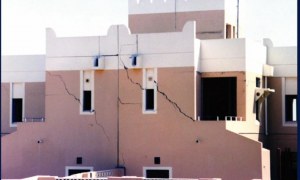🕑 Reading time: 1 minute
Backfilling of sewer sanitary trench is required after installation of sewer pipes. Method of compaction and degree of compaction, equipments and sequence of sewer trench backfilling is discussed. Backfilling process requires substantial cautions and should be carried out properly.
Fig.1: Backfilling of Sewer Sanitary Trench
Contents:
Backfilling of Sewer Sanitary Trench
Following points regarding backfilling of sewer sanitary trench is discussed:- Backfilling consideration
- Backfilling sequence
- Compaction degree
- Selection of compaction equipment
Considerations for Backfilling of Sewer Trench
Sewer sanitary pipe disposition and deterioration need to be prevented while backfilling is carried out. This may be obtained by carefully selecting methods and machines for the task. The determination of backfilling technique is dependent on trench width, properties of excavated materials, degree of compaction and excavation approach.
Sequence of Sewer Sanitary Trench Backfilling
Generally, backfilling begins after concrete structures like arches and cradles have achieved adequate strength and withstand imposed backfill material loads without suffering damages. Backfilling of sewer sanitary trench is composed three main layers including embedment, final backfill and the third layer is finish grade material. It should be noted that each layer requires certain considerations that need to be considered. These zones of sewer sanitary trench backfill is discussed in the following sections:Embedment Zone of Backfilling
It is the first layer and consist of haunching and initial backfill. Backfilling process starts from the selection and placement of embedment materials. The lower backfill layer is extended from the foundation up to 30cm above the pipe. This zone should be placed by hand or suitable machines and properly compacted to avoid dislocation and deterioration of installed pipes. It is recommended to use granular material since the application of considerable compaction efforts to gain specified density is not required. The placement of haunching that extends up to the spring line should be conducted with utmost caution while flexible pipes are used. In the case of high water table, it is required to decrease voids as minimum as possible to prevent the movement of soils.Intermediate Backfill Zone
The selection of intermediate backfill material is commonly influenced by the required compaction degree. However, the use of excavated material is recommended especially in the regions prone to frost heave. The degree of compaction is based on the location of the project for instance 95% modified proctor compaction should be achieved in traffic area, 90% compaction needed in urban areas and small compaction degree will be required in rural area.Upper Backfill Material Zone
The depth and compaction degree of upper zone is controlled by the type of the required finish grade, for instance, the area might be used for agriculture purposes or paved. In the latter case, the elevation of the upper zone need to be established properly to support different pavement layers. In the former case, top soil layer with depth of 100mm shall be provided. Sanitary sewer pipe might be subject to floatation before and during backfilling due to water accumulation in the trench. So, necessary measures need to be considered to prevent such detrimental situation.Degree of Compaction for Sewer Trench Backfilling
The required degree of compaction for sanitary sewer trench backfill is associated with the location of the project. For instance, high compaction degree shall be provided if the area is designated to be paved, but if the region is not heavily populated and do not subjected to heavy traffics less compaction would be satisfactory. Natural settlement of backfill material may be adequate in certain conditions like along outfall sewers in open country. The degree of compaction is computed in accordance with specification provided by American Association of State Highway and Transportation Officials. Modified proctor test is used to evaluate optimum moisture content in the laboratory, and various tests are available for the determination of compaction value in the field.Selection of Compaction Equipment for Backfilling
In this part, the selection of the suitable compaction equipment based on the type of backfill material and the availability of the required space is explored:Compaction Equipment for Cohesive Materials
Generally, small particles and low internal friction are properties by which cohesive materials are characterized. The strength of adhesive force between cohesive material particles make it difficult to reshape the particles and compact it adequately. So, the application of equipment that impose great impact is advised to overcome adhesive forces and relocate particles and eventually obtain desired compaction. For restricted areas, the utilization of pneumatic tamper, engine driven rammer and self-propelled rammer is recommended to use whereas sheep foot roller can be considered for wide area and dozers and loaders may be used if high compaction degree is not needed. Backfill material should be close to optimum moisture content and multiple lifts should be used otherwise the compaction result would be poor and unacceptable. If the moisture content is excessively high, the backfill material should be dried to reach compactible moisture content. Such moisture content may be realized by drying, mixing the material with granular material and pulverizing.


